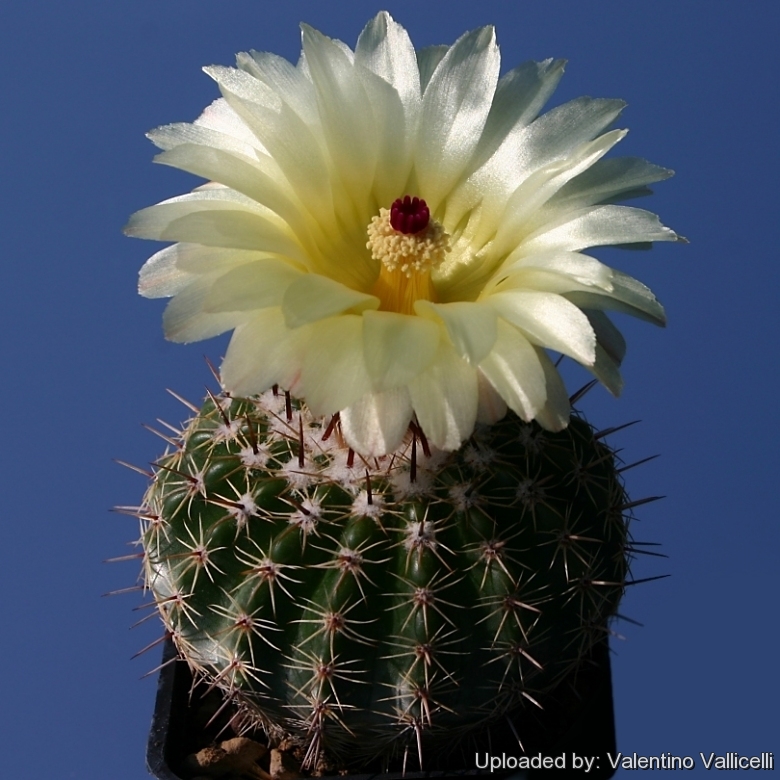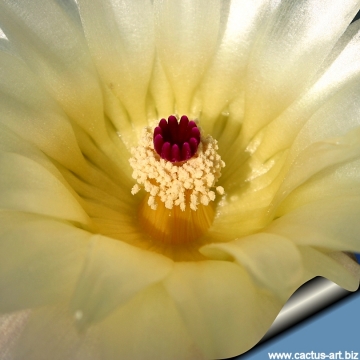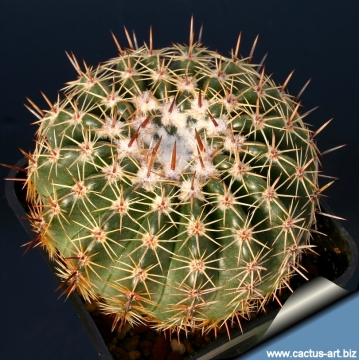Donate now to support the LLIFLE projects.
Your support is critical to our success.
Your support is critical to our success.
= Parodia orthacantha (Link & Otto) Hofacker
Kakteen Sukk. 54: 225 2003. [Sep 2003]
Accepted Scientific Name: Parodia mammulosa (Lem.) N.P.Taylor
Bradleya 5: 93. 1987

Malacocarpus orthacanthus (Parodia orthacantha) Photo by: Valentino Vallicelli
Synonyms:
- Parodia orthacantha (Link & Otto) Hofacker
- Echinocactus orthacanthus Link & Otto
- Malacocarpus orthacanthus (Link & Otto) Herter
- Melocactus orthacanthus Link & Otto
- Notocactus mammulosus var. orthacanthus (Link & Otto) N.Gerloff & Neduchal
- Notocactus orthacanthus (Link & Otto) Vliet
- Wigginsia orthacantha (Link & Otto) Backeb.
See all synonyms of Parodia mammulosa
back
Accepted name in llifle Database:Parodia mammulosa (Lem.) N.P.Taylor
Bradleya 5: 93. 1987
Synonymy: 51
- Parodia mammulosa (Lem.) N.P.Taylor
- Echinocactus mammulosus Lem.
- Malacocarpus mammulosus (Lem.) Britton & Rose
- Notocactus mammulosus (Lem.) A.Berger
- Ritterocactus mammulosus (Lem.) Doweld
- Echinocactus mammulosus var. hircina Speg.
- Echinocactus mammulosus var. typica Speg.
- Echinocactus pampeanus var. charruana Arechav.
- Echinocactus pampeanus var. rubellianus Arechav.
- Echinocactus pampeanus var. subplana Arechav.
- Notocactus floricomus var. spinosissimus Frič ex Buining
- Notocactus hypocrateriformis (Otto & A.Dietr.) Herter
- Echinocactus hypocrateriformis Otto & A.Dietr.
- Notocactus mammulosus f. cristatoides (F.Ritter) N.Gerloff & Neduchal
- Notocactus cristatoides F.Ritter
- Notocactus mammulosus f. floricomus (Arechav.) N.Gerloff & Neduchal
- Echinocactus floricomus Arechav.
- Notocactus floricomus (Arechav.) A.Berger
- Notocactus mammulosus var. floricomus (Arechav.) Havlíček
- Notocactus mammulosus f. macambarensis (Prestlé) N.Gerloff & Neduchal
- Notocactus macambarensis Prestlé
- Notocactus mammulosus var. megalanthus (H.Schloss. & Bredero) N.Gerloff & Neduchal
- Notocactus megalanthus H.Schloss. & Bredero
- Ritterocactus megalanthus (H.Schloss. & Bredero) Doweld
- Notocactus mammulosus var. pampeanus (Speg.) A.Cast. & Lelong in Descole
- Echinocactus mammulosus var. pampeanus (Speg.) Speg.
- Echinocactus pampeanus Speg.
- Malacocarpus mammulosus var. pampeanus (Speg.) Speg.
- Malacocarpus pampeanus (Speg.) Hosseus
- Notocactus pampeanus (Speg.) A.Berger ex Backeb. & F.M.Knuth
- Notocactus mammulosus var. paulus (H.Schloss. & Bredero) Havlíček
- Notocactus paulus H.Schloss. & Bredero
- Notocactus ritterianus Lisal & Kolarik
- Notocactus roseoluteus Vliet
- Notocactus cupreatus
- Notocactus herteri f. roseoluteus (Vliet) N.Gerloff & Neduchal
- Notocactus velenovskii Frič
- Notocactus floricomus var. velenovskii (Frič) Krainz
- Parodia mammulosa f. cristata (P.V.Heath) hort.
- Notocactus mammulosus f. cristatus P.V.Heath
- Parodia mammulosa f. monstruosa cristata hort.
- Parodia mueller-moelleri (Frič ex Backeb. & F.M.Knuth)
- Parodia orthacantha (Link & Otto) Hofacker
- Echinocactus orthacanthus Link & Otto
- Malacocarpus orthacanthus (Link & Otto) Herter
- Melocactus orthacanthus Link & Otto
- Notocactus mammulosus var. orthacanthus (Link & Otto) N.Gerloff & Neduchal
- Notocactus orthacanthus (Link & Otto) Vliet
- Wigginsia orthacantha (Link & Otto) Backeb.
- Parodia submammulosa subs. minor R.Kiesling
Parodia mammulosa subs. brasiliensis (Havlíček) Hofacker
Cactaceae Consensus Init. 6: 11 11 1998
Synonymy: 3
- Parodia mammulosa subs. brasiliensis (Havlíček) Hofacker
- Notocactus mammulosus var. brasiliensis Havlíček
- Ritterocactus mammulosus subs. brasiliensis (Havlíček) Doweld
Parodia mammulosa subs. erythracantha (H.Schloss. & Bredero) Hofacker
Cactaceae Consensus Init. 6: 11. 1998
Synonymy: 4
- Parodia mammulosa subs. erythracantha (H.Schloss. & Bredero) Hofacker
- Notocactus erythracanthus H.Schloss. & Bredero
- Notocactus mammulosus var. erythracanthus (H.Schloss. & Bredero) N.Gerloff & Neduchal
- Ritterocactus mammulosus subs. erythracanthus (H.Schloss. & Bredero) Doweld
Parodia mammulosa subs. submammulosa (Lem.) Hofacker
Cactaceae Consensus Init. 6: 11. 1998
Synonymy: 6
- Parodia mammulosa subs. submammulosa (Lem.) Hofacker
- Echinocactus mammulosus var. submammulosus (Lem.) Speg.
- Echinocactus submammulosus Lem.
- Notocactus submammulosus (Lem.) Backeb.
- Parodia submammulosa (Lem.) R.Kiesling
- Ritterocactus mammulosus subs. submammulosus (Lem.) Doweld
back

Malacocarpus orthacanthus (Parodia orthacantha) Photo by: Cactus Art

Malacocarpus orthacanthus (Parodia orthacantha) Photo by: Cactus Art
| Your Actions | |
|---|---|
| Back to Malacocarpus index | |
| Back to Cactaceae index | |
 |
Back to Cacti Encyclopedia index |








